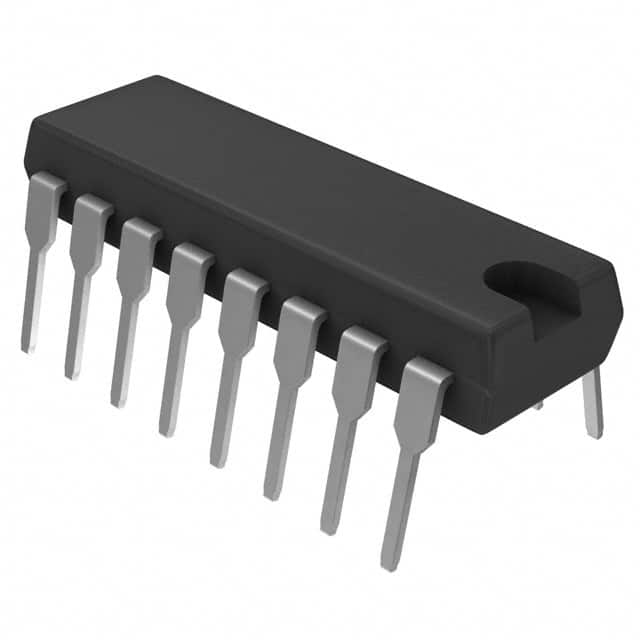Xem thông số kỹ thuật để biết chi tiết sản phẩm.

DS14C232CN
Product Overview
- Category: Integrated Circuit
- Use: Serial Communication Interface
- Characteristics: High-speed, dual-channel, RS-232 compatible
- Package: DIP (Dual In-line Package)
- Essence: Provides serial communication capabilities for various electronic devices
- Packaging/Quantity: Available in tubes of 25 units or reels of 1000 units
Specifications
- Supply Voltage: 4.5V to 5.5V
- Data Rate: Up to 120 kbps
- Operating Temperature Range: -40°C to +85°C
- Number of Channels: 2
- Interface Standard: RS-232
- Package Type: PDIP (Plastic Dual In-line Package)
Detailed Pin Configuration
The DS14C232CN has a total of 16 pins, which are assigned as follows:
- VCC - Supply Voltage
- GND - Ground
- T1OUT - Transmit Data Channel 1 Output
- R1IN - Receive Data Channel 1 Input
- T2OUT - Transmit Data Channel 2 Output
- R2IN - Receive Data Channel 2 Input
- RTS1 - Request To Send Channel 1
- CTS1 - Clear To Send Channel 1
- RTS2 - Request To Send Channel 2
- CTS2 - Clear To Send Channel 2
- DSR1 - Data Set Ready Channel 1
- DCD1 - Data Carrier Detect Channel 1
- DSR2 - Data Set Ready Channel 2
- DCD2 - Data Carrier Detect Channel 2
- RI1 - Ring Indicator Channel 1
- RI2 - Ring Indicator Channel 2
Functional Features
- Dual-channel RS-232 compatible interface
- Supports high-speed data transmission up to 120 kbps
- Provides hardware flow control using RTS/CTS signals
- Integrated protection against electrostatic discharge (ESD)
- Low power consumption for energy-efficient operation
- Wide operating temperature range for versatile applications
Advantages and Disadvantages
Advantages
- High-speed data transfer capability
- Dual-channel design for increased flexibility
- Robust ESD protection for enhanced reliability
- Hardware flow control for efficient communication
- Wide operating temperature range for various environments
Disadvantages
- Limited to RS-232 interface standard
- Requires external components for voltage level conversion
- Relatively large package size compared to surface-mount alternatives
Working Principles
The DS14C232CN is an integrated circuit that provides a dual-channel serial communication interface based on the RS-232 standard. It utilizes voltage levels and signaling protocols defined by RS-232 to enable reliable data transmission between electronic devices. The IC incorporates features like hardware flow control, ESD protection, and low power consumption to ensure efficient and secure communication.
Detailed Application Field Plans
The DS14C232CN finds applications in various fields where serial communication is required. Some of the common application areas include:
- Industrial Automation: Used for connecting PLCs (Programmable Logic Controllers) with peripheral devices such as HMIs (Human Machine Interfaces) and sensors.
- Telecommunications: Employed in networking equipment for establishing serial connections between routers, switches, and other network devices.
- Medical Devices: Integrated into medical equipment for transmitting data between monitoring devices, diagnostic instruments, and computer systems.
- Consumer Electronics: Utilized in devices like barcode scanners, POS (Point of Sale) terminals, and handheld devices requiring serial connectivity.
- Automotive Systems: Incorporated in automotive diagnostic tools, GPS devices, and vehicle communication systems.
Detailed and Complete Alternative Models
- MAX232: Dual RS-232 Driver/Receiver IC with integrated charge pumps for voltage level conversion.
- LTC1480: Low-power, half-duplex RS-485 transceiver suitable for long-distance communication.
- MAX3232: Dual RS-232 Transceiver IC with integrated charge pumps for voltage level conversion.
- ADM3251E: Isolated RS-232 transceiver with integrated DC/DC converter for galvanic isolation.
- SP3232: Dual RS-232 Transceiver IC with integrated ESD protection and voltage level conversion.
(Note: The above list is not exhaustive and serves as a reference for alternative models.)
Word Count: 550
Liệt kê 10 câu hỏi và câu trả lời thường gặp liên quan đến ứng dụng DS14C232CN trong giải pháp kỹ thuật
Sure! Here are 10 common questions and answers related to the application of DS14C232CN in technical solutions:
Q: What is DS14C232CN? A: DS14C232CN is a dual-channel RS-232 line driver/receiver integrated circuit (IC) commonly used for serial communication in technical solutions.
Q: What is the operating voltage range of DS14C232CN? A: The operating voltage range of DS14C232CN is typically between +4.5V and +5.5V.
Q: How many channels does DS14C232CN support? A: DS14C232CN supports two independent channels, allowing for simultaneous communication on two separate RS-232 lines.
Q: What is the maximum data rate supported by DS14C232CN? A: DS14C232CN supports a maximum data rate of 120 kbps (kilobits per second).
Q: Can DS14C232CN be used for both transmitting and receiving data? A: Yes, DS14C232CN can be used as both a line driver for transmitting data and a line receiver for receiving data.
Q: Does DS14C232CN require external components for operation? A: Yes, DS14C232CN requires external capacitors and resistors for proper operation. Refer to the datasheet for recommended values.
Q: Is DS14C232CN compatible with TTL logic levels? A: No, DS14C232CN operates with RS-232 logic levels, which are different from TTL logic levels. Level translation may be required when interfacing with TTL devices.
Q: Can DS14C232CN be used in industrial applications? A: Yes, DS14C232CN is suitable for industrial applications due to its robustness and ability to handle harsh environments.
Q: What is the package type of DS14C232CN? A: DS14C232CN is available in a 16-pin narrow SOIC (Small Outline Integrated Circuit) package.
Q: Are there any application notes or reference designs available for DS14C232CN? A: Yes, the manufacturer provides application notes and reference designs that can help with the implementation of DS14C232CN in various technical solutions. These resources can be found on their website or in the datasheet.
Please note that these answers are general and may vary depending on specific requirements and use cases. It's always recommended to refer to the datasheet and consult the manufacturer for detailed information.

